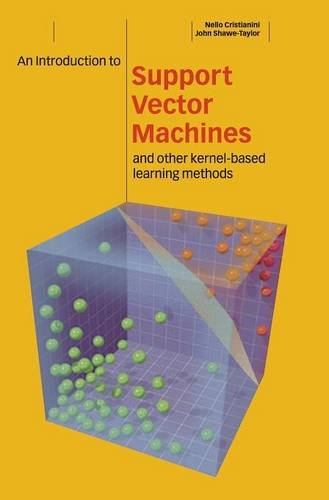An Introduction to Support Vector Machines and Other Kernel-based Learning Methods pdf
Par smith joshua le dimanche, janvier 29 2017, 03:17 - Lien permanent
An Introduction to Support Vector Machines and Other Kernel-based Learning Methods. John Shawe-Taylor, Nello Cristianini

An.Introduction.to.Support.Vector.Machines.and.Other.Kernel.based.Learning.Methods.pdf
ISBN: 0521780195,9780521780193 | 189 pages | 5 Mb

An Introduction to Support Vector Machines and Other Kernel-based Learning Methods John Shawe-Taylor, Nello Cristianini
Publisher: Cambridge University Press
Those are support vector machines, kernel PCA, etc.). Support vector machines are a relatively new classification or prediction method developed by Cortes and Vapnik21 in the 1990s as a result of the collaboration between the statistical and the machine-learning research communities. Since their appearance in the early nineties, support vector machines and related kernel-based methods have been successfully applied in diverse fields of application such as bioinformatics, fraud detection, construction of insurance tariffs, direct marketing, and data and text As a consequence, SVMs now play an important role in statistical machine learning and are used not only by statisticians, mathematicians, and computer scientists, but also by engineers and data analysts. A Research Frame Work of machine learning in data mining. 96: Introduction to Aircraft Performance, Selection and Design 95: An Introduction to Support Vector Machines and Other Kernel based Learning Methods 94: Practical Programming in TLC and TK 4th ed. More formally, a support vector machine constructs a hyperplane or set of hyperplanes in a high- or infinite-dimensional space, which can be used for classification, regression, or other tasks. Introduction:- A data warehouse is a central store of data that has been extracted from operational data. Support vector machines map input vectors to a higher dimensional space where a maximal separating hyperplane is constructed. Download Free eBook:An Introduction to Support Vector Machines and Other Kernel-based Learning Methods - Free chm, pdf ebooks rapidshare download, ebook torrents bittorrent download. Support Vector Machines (SVM) [19] with an edit distance-based kernel function among these dependency paths [17] was used to classify whether a path describes an interaction between a gene or a gene-vaccine pair. Kernel Methods for Pattern Analysis - The Book This book is the first comprehensive introduction to Support Vector Machines (SVMs), a new generation learning system based on recent advances in statistical learning. Collective Intelligence" first, then "Collective Intelligence in Action". Introduction to Lean Manufacturing, Mathematical Programming Modeling for supervised learning (classification analysis, neural networks, support vector machines); unsupervised learning (clustering, dimensionality reduction, kernel methods ); learning theory (bias/variance tradeoffs; All the topics will be based on applications of ML and AI, such as robotics control, data mining, search games, bioinformatics, text and web data processing. An Introduction to Support Vector Machines and Other Kernel-based Learning Methods. It focuses on large scale machine learning, The introduction from the main site is worth citing: (Shogun's) focus is on large scale kernel methods and especially on Support Vector Machines (SVM) [1]. Several experiments are already done to learn and train the network architecture for the data set used in back propagation neural N/W with different activation functions. The Shogun Toolbox is an extremely impressive meta-framework for incorporating support vector machine and kernel method-based supervised machine learning into various exploratory data analysis environments. An Introduction to Support Vector Machines and other kernel-based learning methods. The first one shows how easy it is to implement basic algorithms, the second one would show you how to use existing open source projects related to machine learning. Data in a data warehouse is typically subject-oriented, non-volatile, and of . Over 170,000 fever-related articles from PubMed abstracts and titles were retrieved and analysed at the sentence level using natural language processing techniques to identify genes and vaccines (including 186 Vaccine Ontology terms) as well as their interactions .